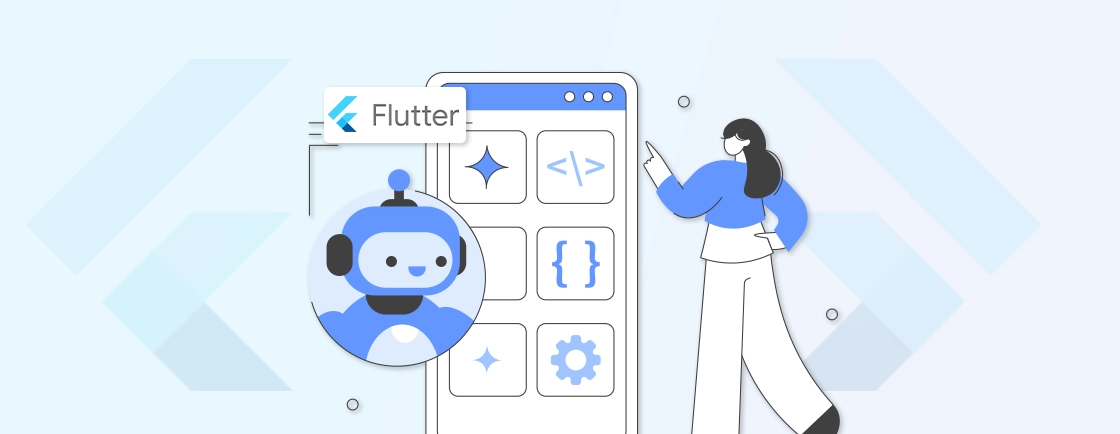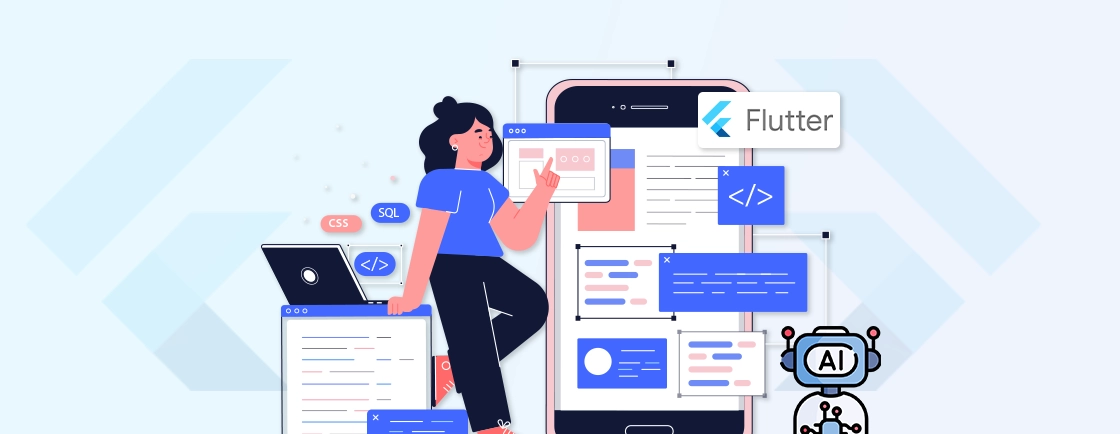Table of Contents
Imagine building a mobile app, only to face sluggish performance, inconsistent UI, and costly platform-specific fixes. Flutter’s architecture solves these challenges by enabling a single codebase for seamless cross-platform development.
At its core, Flutter combines a reactive framework, customizable widgets, and the Dart language. That means fast, visually-consistent apps. Understanding Flutter’s layered architecture involves everything from the embedding layer to the framework.
So let’s try and work out the basics of Flutter architecture. And, you’ll learn how the Flutter app experts build robust, future-proof applications. Here we go.
What is Flutter Architecture?
Flutter’s architecture is a layered, cross-platform framework designed to build high-performance apps from a single Dart codebase. It combines a reactive UI framework, a high-performance rendering engine, and platform-specific embedders. That helps deliver native-like experiences on Android, iOS, web, and desktop.
This architecture eliminates platform-specific UI inconsistencies while maintaining direct access to native features. That makes it ideal for startups and enterprises alike.
Core Components of Flutter Architecture
Flutter’s architecture is designed for speed, flexibility, and consistency across platforms. Its foundation is a layered structure that ensures smooth rendering and native-like performance. It also offers efficient state management. The framework operates on three key layers:
Embedder (Platform-specific Layer)
The Embedder is the lowest layer of Flutter architecture. It’s written in platform-native languages (Java/Kotlin for Android, Objective-C/Swift for iOS, C++ for desktop).
Key Components
- Render Surface Setup: Provides a canvas for Flutter to draw on (e.g., SurfaceView on Android, Metal on iOS).
- Thread Management: Coordinates UI, GPU, and I/O threads.
- Native Plugins: Integrates platform-specific features (e.g., sensors, Bluetooth).
- App Packaging: Bundles Flutter code into a native executable (APK/IPA).
- Event Loop Interop: Syncs Flutter’s event loop with the OS.
The purpose of the embedded layer is to ensure Flutter runs seamlessly on Android, iOS, web, and desktop.
Engine (Core Layer)
Written primarily in C++, the Engine is Flutter’s powerhouse. It powers Flutter’s high-performance rendering and execution.
Key Components
- Skia Graphics Engine: Renders pixels on the screen.
- Dart Runtime: Executes Dart code (JIT for development, AOT for production).
- Platform Channels: Enables communication with native APIs (e.g., camera, GPS).
- Text Layout: Handles font rendering and text display.
- Frame Scheduling: Manages smooth animations at 60/120 FPS.
- System Events: Processes input (taps, scrolls) and lifecycle events.
The purpose of this layer is to ensure fast, consistent performance across devices. That is, regardless of the OS they run on–Android or iOS.
Framework (Dart Layer)
The topmost layer, written in Dart, provides developers with ready-to-use tools and widgets. This layer is where developers spend most of their time. It handles platform-specific integrations and provides the necessary tools for building UIs.
Key Components
- Widgets: Reusable UI building blocks (e.g., Material for Android-style and Cupertino for iOS-style designs).
- Rendering: Converts widget hierarchies into a visual layout.
- Animation: Handles motion and transitions.
- Painting: Manages low-level graphics (e.g., shapes, borders).
- Gestures: Processes touch and input interactions.
- Foundation: Core utilities (e.g., runApp(), base classes).
The purpose of this layer is to simplify UI development while maintaining full customization.
As you may understand from the architecture, Flutter helps you build a single codebase for multiple platforms. But we need to check how each of these components work.
How Does Flutter Work?
Flutter is a cross-platform UI toolkit. It compiles Dart code to native apps for Android, iOS, web, and desktop. Here’s how it works:
Step 1: Widget Tree Construction (Dart Framework)
Flutter apps begin as a declarative blueprint—a hierarchy of widgets built in Dart. Each widget (like Text, Button, or ListView) is a lightweight, immutable configuration that describes part of the UI.
The framework combines these widgets into a widget tree, where parent widgets nest child widgets to define layout and behavior.
What makes Flutter unique? Widgets aren’t just placeholders—they’re blueprints for rendering, which the framework later “inflates” into actual pixels.
Step 2: Rendering & Layout
Once the widget tree is built, Flutter’s rendering layer takes over. It converts widgets into render objects—a parallel tree of heavier, mutable objects that handle:
- Layout: Calculating sizes and positions (e.g., a Row widget measures its children).
- Constraints: Enforcing parent-child size rules (e.g., “maxWidth = 300px”).
Flutter’s layout engine is single-pass and depth-first, meaning it efficiently resolves constraints in one sweep. Unlike web browsers (which use CSS’s multi-pass layout), Flutter avoids “layout thrashing” by design.
Step 3: Painting & Compositing (Engine Layer)
Now, the Engine (written in C++) transforms render objects into pixels. Here’s how:
- Painting: The Canvas API (powered by Skia) draws shapes, text, and images onto layers.
- Compositing: Layers are stacked and merged (e.g., opacity effects, clipping).
Flutter’s secret sauce? Retained rendering: Instead of redrawing everything, it intelligently repaints only damaged areas (like game engines). Skia’s GPU acceleration ensures buttery-smooth animations.
Step 4: Display (Embedder Layer)
The final step happens in the Embedder, where Flutter’s output meets the native OS:
- The Engine sends a rasterized scene (a bitmap) to the embedder.
- The embedder (e.g., Android’s FlutterView) plasters this onto a platform surface (like a SurfaceView).
- Input events (taps, scrolls) flow back up the layers through the same pipeline.
It’s Flutter’s “translator” for platform quirks, handling thread synchronization, vsync signals, and memory buffers. Without it, Flutter wouldn’t run on any OS.
Flutter works by compiling Dart to native code, rendering UI directly, and integrating tightly with platforms. Developers have full control without sacrificing performance.
Our Flutter app development company works on each of these steps individually and meticulously to ensure the mobile apps are of the highest quality.
Best Practices for Flutter Architecture
To build scalable, maintainable, and high-performance Flutter apps, follow these architectural best practices:
Adopt a Clear App Structure
Think of your Flutter app like a well-organized library—not a junk drawer. Group files by feature (e.g., auth/, dashboard/) rather than type (e.g., models/, screens/). This scales better and makes navigation intuitive.
Go for something like this.
lib/
├── features/
│ ├── auth/
│ │ ├── presentation/ # Widgets
│ │ ├── domain/ # Business logic
│ │ └── data/ # APIs & local storage
│ └── dashboard/
│ ├── presentation/
│ └── domain/
└── core/ # Shared utilities
├── constants/
├── themes/
└── services/
Here’s what you need to avoid.
lib/
├── widgets/
├── models/
├── screens/
└── services/
This practice is important as feature-first organization scales better and reduces merge conflicts.
Choose the Right State Management
Flutter’s golden rule: “Everything’s a widget, but not everything should be rebuilt.” Pick a state solution early based on app complexity:
- Provider/Riverpod: Ideal for 90% of apps (simple, flexible).
- Bloc: Great for event-heavy flows (logins, wizards).
- Redux: Overkill for most—but shines in apps with undo/redo history.
Avoid defaulting to setState() for app-wide state—it’s like using duct tape for plumbing.
Implement Clean Architecture
Separate concerns like a chef prepping ingredients—business logic shouldn’t care if data comes from Firebase or a local DB. Follow these layers:
- Presentation: Widgets + state management.
- Domain: Pure Dart business rules (zero Flutter dependencies).
- Data: APIs, databases, DTOs.
Here’s a bonus. Use dependency injection (get_it, riverpod) to keep layers decoupled.
Optimize Performance Early
Flutter is fast—until it’s not. Profile first, optimize second:
- const widgets: Prevent unnecessary rebuilds.
- ListView.builder: Lazily loads items (don’t use Column for 1000 items!).
- Avoid Opacity: Use AnimatedOpacity or pre-rendered assets.
Run flutter run –profile and check the DevTools timeline.
Leverage Platform Channels Wisely
Need native features? Platform channels are your bridge—but don’t overuse them. Best practices:
- Batch calls: Minimize Dart ↔ native roundtrips (e.g., fetch all sensors at once).
- Fallbacks: Gracefully handle missing features (e.g., use MethodChannel’s try/catch).
- Plugins: Prefer community-vetted plugins (camera, geolocation) over reinventing the wheel.
Write Testable Code
Tests are your safety net. Design for testability:
- Mock dependencies: Use mockito or mocktail.
- Small, pure functions: Easy to unit test (e.g., validateEmail()).
- Widget tests: Test UI with flutter_test (tap buttons, verify text).
Aim for 70%+ coverage, but focus on critical paths (logins, payments).
Plan for Internationalization
Even if you’re launching in one language, structure for i18n early:
- Arb files: Flutter’s standard for translations (intl package).
- Placeholders: Hello {name} instead of Hello $name (supports RTL languages).
- Dynamic fonts: Some languages (e.g., Arabic) need larger text.
Here’s a pro tip. Use flutter gen-l10n to auto-generate localization boilerplate.
CI/CD & Static Analysis
Automate quality gates to catch bugs before users do:
- CI/CD: GitHub Actions, Codemagic (run tests, build APK/IPA).
- Static analysis: Enforce rules with analysis_options.yaml (ban print(), require const).
- Code formatting: dart format . to keep style consistent.
Remember this golden rule. Never merge code that decreases test coverage.
These practices are like guardrails to ensure your Flutter-based app is maintainable, performant, and ready to scale.
Let’s Summarize
Flutter’s architecture isn’t just a technical detail—it’s the foundation that makes the framework powerful. It combines a reactive UI framework with a high-performance rendering engine and seamless platform integration.
That means the best of both worlds: the productivity of a single codebase and the flexibility to go native when needed. Flutter’s approach proves that cross-platform development doesn’t compromise on speed, control, or UX.
Want to build a top-tier cross-platform mobile app with seamless performance? Hire Flutter App Developers to turn your idea into a high-quality, scalable solution.
FAQs on Flutter Architecture
Why does Flutter use widgets for everything?
Widgets are lightweight, immutable blueprints that Flutter efficiently rebuilds and compares to update only what changes, enabling reactive UIs without manual DOM diffing or platform-specific view hierarchies.
How does state management fit into Flutter’s architecture?
State solutions like Provider or Bloc sit between widgets and business logic. It rebuilds only affected UI parts when data changes, keeping the framework layer decoupled from app logic.
How does hot reload work under the hood for Flutter?
Flutter’s Dart VM (in debug mode) injects updated code while preserving app state and widget tree. It leverages JIT compilation to refresh the UI in under a second without restarting.
How does Flutter handle platform differences?
The embedder layer abstracts OS specifics (e.g., input handling, threading). And framework widgets like MaterialApp and CupertinoApp adapt visuals to platform conventions.
What makes Flutter’s rendering fast?
Skia, Flutter’s graphics engine, paints directly to a platform canvas with GPU acceleration. That helps avoid intermediate layers like in web browsers or OEM widget systems, while Dart’s AOT compilation boosts runtime speed.
Accelerate Development with Flutter
Build high-performance mobile, web, and desktop experiences from one unified Flutter codebase.





